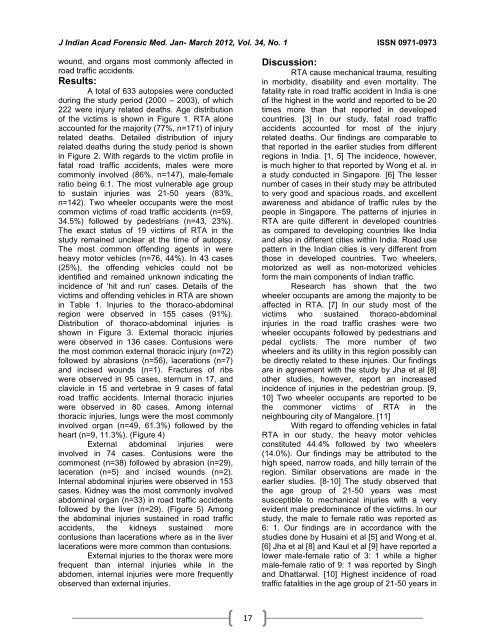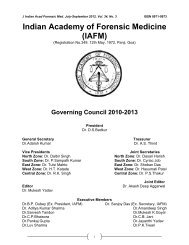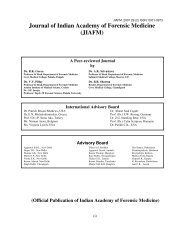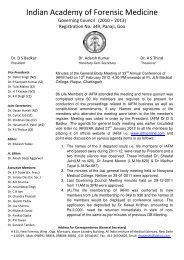Indian Academy of Forensic Medicine (IAFM) - Official website of IAFM
Indian Academy of Forensic Medicine (IAFM) - Official website of IAFM
Indian Academy of Forensic Medicine (IAFM) - Official website of IAFM
Create successful ePaper yourself
Turn your PDF publications into a flip-book with our unique Google optimized e-Paper software.
J <strong>Indian</strong> Acad <strong>Forensic</strong> Med. Jan- March 2012, Vol. 34, No. 1 ISSN 0971-0973<br />
wound, and organs most commonly affected in<br />
road traffic accidents.<br />
Results:<br />
A total <strong>of</strong> 633 autopsies were conducted<br />
during the study period (2000 – 2003), <strong>of</strong> which<br />
222 were injury related deaths. Age distribution<br />
<strong>of</strong> the victims is shown in Figure 1. RTA alone<br />
accounted for the majority (77%, n=171) <strong>of</strong> injury<br />
related deaths. Detailed distribution <strong>of</strong> injury<br />
related deaths during the study period is shown<br />
in Figure 2. With regards to the victim pr<strong>of</strong>ile in<br />
fatal road traffic accidents, males were more<br />
commonly involved (86%, n=147), male-female<br />
ratio being 6:1. The most vulnerable age group<br />
to sustain injuries was 21-50 years (83%,<br />
n=142). Two wheeler occupants were the most<br />
common victims <strong>of</strong> road traffic accidents (n=59,<br />
34.5%) followed by pedestrians (n=43, 23%).<br />
The exact status <strong>of</strong> 19 victims <strong>of</strong> RTA in the<br />
study remained unclear at the time <strong>of</strong> autopsy.<br />
The most common <strong>of</strong>fending agents in were<br />
heavy motor vehicles (n=76, 44%). In 43 cases<br />
(25%), the <strong>of</strong>fending vehicles could not be<br />
identified and remained unknown indicating the<br />
incidence <strong>of</strong> ‘hit and run’ cases. Details <strong>of</strong> the<br />
victims and <strong>of</strong>fending vehicles in RTA are shown<br />
in Table 1. Injuries to the thoraco-abdominal<br />
region were observed in 155 cases (91%).<br />
Distribution <strong>of</strong> thoraco-abdominal injuries is<br />
shown in Figure 3. External thoracic injuries<br />
were observed in 136 cases. Contusions were<br />
the most common external thoracic injury (n=72)<br />
followed by abrasions (n=56), lacerations (n=7)<br />
and incised wounds (n=1). Fractures <strong>of</strong> ribs<br />
were observed in 95 cases, sternum in 17, and<br />
clavicle in 15 and vertebrae in 9 cases <strong>of</strong> fatal<br />
road traffic accidents. Internal thoracic injuries<br />
were observed in 80 cases. Among internal<br />
thoracic injuries, lungs were the most commonly<br />
involved organ (n=49, 61.3%) followed by the<br />
heart (n=9, 11.3%). (Figure 4)<br />
External abdominal injuries were<br />
involved in 74 cases. Contusions were the<br />
commonest (n=38) followed by abrasion (n=29),<br />
laceration (n=5) and incised wounds (n=2).<br />
Internal abdominal injuries were observed in 153<br />
cases. Kidney was the most commonly involved<br />
abdominal organ (n=33) in road traffic accidents<br />
followed by the liver (n=29). (Figure 5) Among<br />
the abdominal injuries sustained in road traffic<br />
accidents, the kidneys sustained more<br />
contusions than lacerations where as in the liver<br />
lacerations were more common than contusions.<br />
External injuries to the thorax were more<br />
frequent than internal injuries while in the<br />
abdomen, internal injuries were more frequently<br />
observed than external injuries.<br />
17<br />
Discussion:<br />
RTA cause mechanical trauma, resulting<br />
in morbidity, disability and even mortality. The<br />
fatality rate in road traffic accident in India is one<br />
<strong>of</strong> the highest in the world and reported to be 20<br />
times more than that reported in developed<br />
countries. [3] In our study, fatal road traffic<br />
accidents accounted for most <strong>of</strong> the injury<br />
related deaths. Our findings are comparable to<br />
that reported in the earlier studies from different<br />
regions in India. [1, 5] The incidence, however,<br />
is much higher to that reported by Wong et al. in<br />
a study conducted in Singapore. [6] The lesser<br />
number <strong>of</strong> cases in their study may be attributed<br />
to very good and spacious roads, and excellent<br />
awareness and abidance <strong>of</strong> traffic rules by the<br />
people in Singapore. The patterns <strong>of</strong> injuries in<br />
RTA are quite different in developed countries<br />
as compared to developing countries like India<br />
and also in different cities within India. Road use<br />
pattern in the <strong>Indian</strong> cities is very different from<br />
those in developed countries. Two wheelers,<br />
motorized as well as non-motorized vehicles<br />
form the main components <strong>of</strong> <strong>Indian</strong> traffic.<br />
Research has shown that the two<br />
wheeler occupants are among the majority to be<br />
affected in RTA. [7] In our study most <strong>of</strong> the<br />
victims who sustained thoraco-abdominal<br />
injuries in the road traffic crashes were two<br />
wheeler occupants followed by pedestrians and<br />
pedal cyclists. The more number <strong>of</strong> two<br />
wheelers and its utility in this region possibly can<br />
be directly related to these injuries. Our findings<br />
are in agreement with the study by Jha et al [8]<br />
other studies, however, report an increased<br />
incidence <strong>of</strong> injuries in the pedestrian group. [9,<br />
10] Two wheeler occupants are reported to be<br />
the commoner victims <strong>of</strong> RTA in the<br />
neighbouring city <strong>of</strong> Mangalore. [11]<br />
With regard to <strong>of</strong>fending vehicles in fatal<br />
RTA in our study, the heavy motor vehicles<br />
constituted 44.4% followed by two wheelers<br />
(14.0%). Our findings may be attributed to the<br />
high speed, narrow roads, and hilly terrain <strong>of</strong> the<br />
region. Similar observations are made in the<br />
earlier studies. [8-10] The study observed that<br />
the age group <strong>of</strong> 21-50 years was most<br />
susceptible to mechanical injuries with a very<br />
evident male predominance <strong>of</strong> the victims. In our<br />
study, the male to female ratio was reported as<br />
6: 1. Our findings are in accordance with the<br />
studies done by Husaini et al [5] and Wong et al.<br />
[6] Jha et al [8] and Kaul et al [9] have reported a<br />
lower male-female ratio <strong>of</strong> 3: 1 while a higher<br />
male-female ratio <strong>of</strong> 9: 1 was reported by Singh<br />
and Dhattarwal. [10] Highest incidence <strong>of</strong> road<br />
traffic fatalities in the age group <strong>of</strong> 21-50 years in









